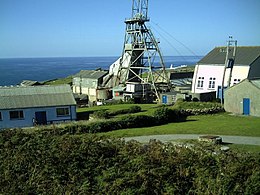Cornwall and West Devon Mining Landscape
| UNESCO World Heritage Site | |
|---|---|
 Part of Crown Mines, Botallack (St Just Mining District) | |
| Location | Cornwall and West Devon, United Kingdom |
| Criteria | Cultural: (ii), (iii), (iv) |
| Reference | 1215 |
| Inscription | 2006 (30th Session) |
| Area | 19,719 ha (48,730 acres) |
| Coordinates | 50°8′10″N 05°23′1″W / 50.13611°N 5.38361°W |
The Cornwall and West Devon Mining Landscape is a
History
Up to the mid-16th century, Devon produced approximately 25-40% of the amount of tin that Cornwall did but the total amount of tin production from both Cornwall and Devon during this period was relatively small. After the 1540s, Cornwall's production took off and Devon's production was only about between a ninth to a tenth of that of Cornwall. From the mid-16th century onwards, the Devon Stannaries were worth very little in income to the King and were sidelined as such following the Supremacy of Parliament Act 1512 (this does not apply to the Stannaries of Cornwall).
The landscapes of Cornwall and West Devon were radically reshaped during the 18th and 19th centuries by deep-lode mining for

The early 19th century also saw a revolution in
Commencing in the early 19th century, significant numbers of mine workers migrated to live and work in mining communities based on Cornish traditions, this flow reaching its zenith at the end of the 19th century. Today numerous migrant-descended Cornish communities flourish around the world and distinctive Cornish-design engine houses can be seen in Australia, New Zealand, South Africa, Mexico, the British Virgin Islands, Spain, and in the mining fields of other parts of England, Wales, Scotland, Ireland, the Channel Islands, and the Isle of Man.
A much reduced mining industry continued in Cornwall after the copper crash of the 1860s with production mainly focused on tin. Metalliferous mining finally ceased in Cornwall in 1998 with the closure of South Crofty Mine, Pool, the last tin mine to operate in Europe.
Areas

The World Heritage Site comprises discrete but thematically linked areas spanning Cornwall and West Devon. The areas (with the area codes from the site nomination) are:[5]
- A1 - St Just Mining District
- A2 - Port of Hayle
- A3i - Tregonning and Gwinear Mining District
- A3ii - Trewavas
- A4 - Wendron Mining District
- A5i - Camborne and Redruth Mining District
- A5ii - Wheal Peevor
- A5iii - Portreath Harbour
- A6i - Gwennap Mining District
- A6ii - Perran Foundry
- A6iii - Kennall Vale
- A7 - St Agnes Mining District
- A8i - Luxulyan Valley
- A8ii - Charlestown
- A9 - Caradon Mining District
- A10i - Tamar Valley
- A10ii - Tavistock
See also
- Wheel Wreck, a shipwreck containing Cornish mining equipment, now protected by Historic England
- The Mineral Tramway Trails, a set of public trails following former tram and rail routes in Cornwall's central mining district
References
- ^ Cornwall News (8 November 2012). "Unseco threaten to pull South Crofty mining 'world heritage status' if mining starts". falmouthpacket.co.uk.
- ^ Simon Parker (21 June 2013). "UN threat to Devon and Cornwall's heritage site status". westernmorningnews.co.uk. Archived from the original on 9 August 2014. Retrieved 27 July 2014.
- ^ "Decisions Adopted (38th Session 2014)" (PDF). UNESCO World Heritage. UNESCO World Heritage Centre. Retrieved 16 October 2014.
- ^ "Cornwall and West Devon Mining Landscape Current conservation issues 2014". unesco.org.
- ^ "The World Heritage Site Areas". Cornwall & Scilly Historic Environment Service. 2006. Archived from the original on 26 April 2007. Retrieved 25 May 2007.



